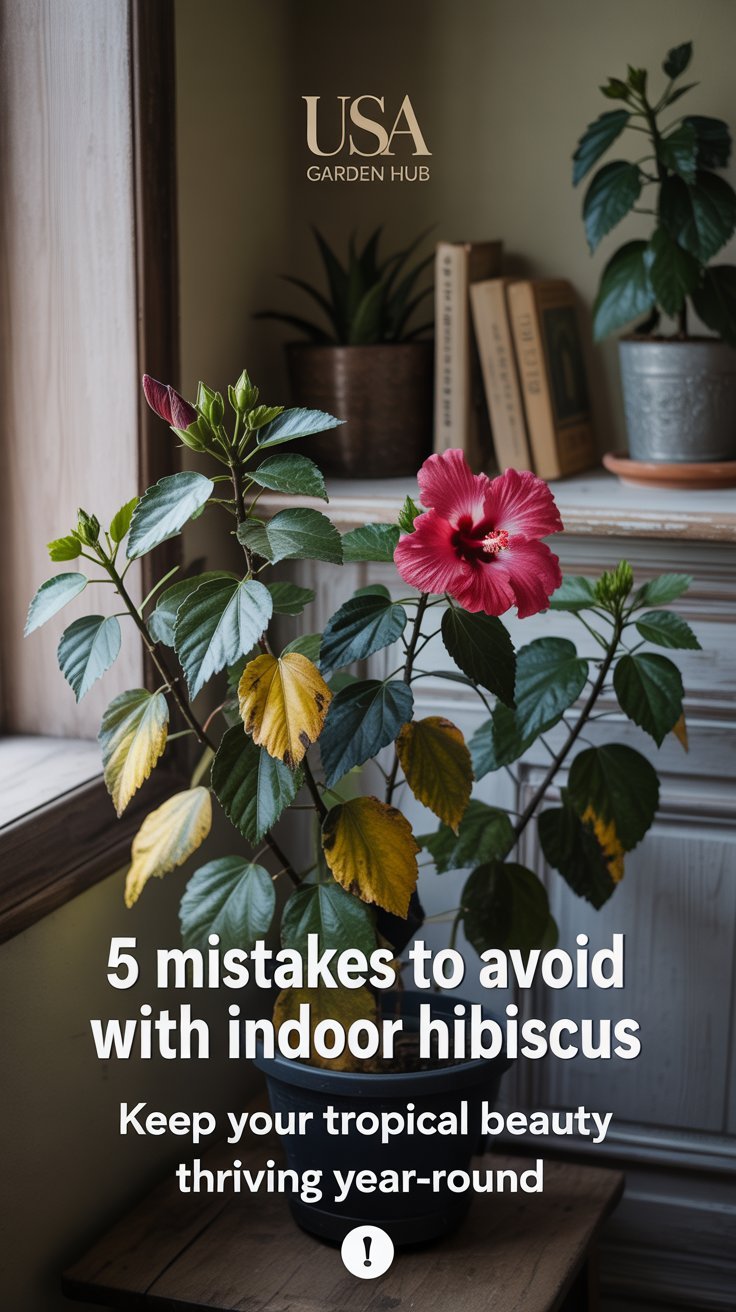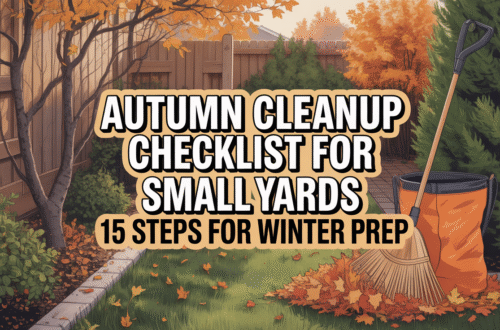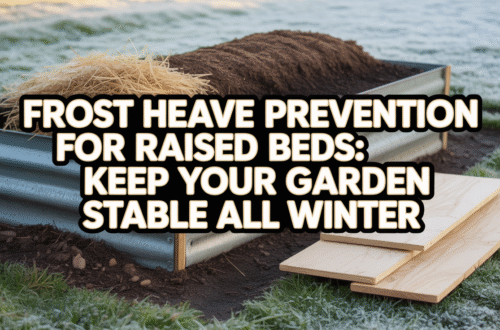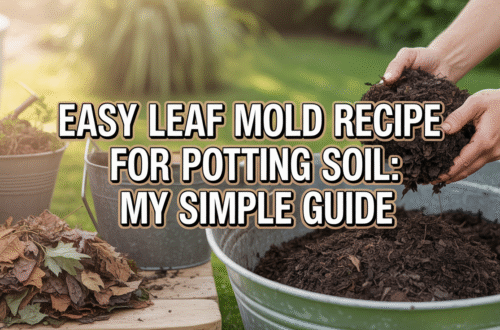Learn the top 5 mistakes to avoid with indoor hibiscus to keep your plant healthy and blooming. Simple tips from a 10-year gardening pro!

Hey there, plant lovers! I’m Ashley Scott, and I’ve been gardening for over 10 years. If you’re like me, you adore the vibrant blooms of an indoor hibiscus plant. They’re like a little piece of the tropics right in your living room! But here’s the thing—hibiscus plants can be a bit finicky indoors. I’ve made my fair share of mistakes over the years, and I want to save you the trouble. In this article, I’ll share the 5 Mistakes to Avoid with Indoor Hibiscus so you can keep yours healthy, blooming, and pest-free. Let’s dive in!
Mistake 1: Neglecting Pest Control
Indoor hibiscus plants are like magnets for pests—think aphids, spider mites, and those pesky whiteflies. I learned this the hard way when I spotted tiny green specks moving on my hibiscus leaves. Yep, aphids had turned my plant into their personal buffet!
Why It’s a Problem
Pests suck the life out of your hibiscus by feeding on its sap. This weakens the plant, causes leaves to yellow or curl, and can even stop it from flowering. Worse, they might spread nasty plant viruses. Trust me, a hibiscus insect problem is no joke!
How to Avoid It
- Check your plant weekly. Flip those leaves over and peek along the stems.
- If you spot pests, act fast! Use insecticidal soap or neem oil to send them packing.
- Want a natural fix? Ladybugs are aphid-eating superheroes—release a few near your plant.
- Quarantine new plants before they join your hibiscus to avoid sneaky pest hitchhikers.
My Story
Once, my hibiscus was crawling with aphids. I tried hosing them off, but they kept coming back like uninvited guests. Finally, I mixed water with a drop of dish soap, sprayed it on, and let it sit overnight. The next day, I rinsed it off, and poof—problem solved! Now I know how to prevent hibiscus plant from insects, and you can too.
For more pest-fighting tips, check out my guide on How to Identify and Treat Common Plant Pests.
Mistake 2: Improper Watering
Watering seems simple, right? But with hibiscus, it’s easy to overdo it or skimp too much. I’ve drowned a plant or two in my early days—oops!
Why It’s a Problem
Overwatering leads to root rot, where the roots turn mushy and the plant suffers. Underwatering stresses it out, causing wilting and hibiscus flower problems like fewer blooms. Either way, your plant won’t be happy.
How to Avoid It
- Stick your finger an inch into the soil. Dry? Time to water. Wet? Hold off.
- Use a pot with drainage holes—standing water is a hibiscus killer.
- In winter, cut back since the plant slows down.
My Tip
I call it the “finger test.” If my finger’s dry, I grab the watering can. I also use room-temperature water to avoid shocking the roots. It’s a small trick that keeps my hibiscus thriving.
Need more watering advice? See my post on Watering Indoor Plants.
Mistake 3: Inadequate Light
Hibiscus plants crave sunshine like I crave coffee in the morning. Without enough light, they just won’t perform.
Why It’s a Problem
Too little light makes your hibiscus leggy, with sparse leaves and no flowers. It’s a common reason for “what to do if hibiscus is not flowering.” Plus, a weak plant invites pests and diseases.
How to Avoid It
- Give it at least 6 hours of direct sunlight daily. A south-facing window is perfect.
- No sunny spot? A grow light works wonders.
- Rotate the pot now and then for even light exposure.
My Experience
My hibiscus was sulking in a dim corner until I moved it to a sunny window. Within weeks, it exploded with blooms! Light is key to maintaining hibiscus plant health—don’t skimp on it.
Learn more about indoor lighting from University of Minnesota Extension.
Mistake 4: Incorrect Temperature and Humidity
Hibiscus plants dream of warm, humid days. Cold drafts or dry air? Not their vibe.
Why It’s a Problem
Temperatures below 50°F can make leaves drop like flies. Low humidity dries out the leaves, leading to fewer blooms and a sad-looking plant. It’s a recipe for stress!
How to Avoid It
- Keep the room between 60°F and 75°F—cozy for you and your hibiscus.
- Boost humidity with a misting bottle, a tray of water with pebbles, or a humidifier.
- Avoid drafty windows or heaters that dry the air.
My Trick
In winter, I set up a pebble tray under my hibiscus. The evaporating water keeps it humid, and I’ve dodged crispy leaves ever since. It’s a simple way to keep hibiscus plant healthy.
Check out Clemson University Cooperative Extension for more climate tips.
Mistake 5: Lack of Proper Fertilization
Fertilizing can feel like a chore, but skip it, and your hibiscus will let you know. I’ve seen plants go from blah to blooming with the right nutrients.
Why It’s a Problem
Without fertilizer, your hibiscus might not flower, or the blooms will be tiny and dull. Overdoing it, though, can burn the roots. Balance is everything!
How to Avoid It
- Use a balanced fertilizer like 10-10-10 or 20-20-20 every two weeks in spring and summer.
- Dial it back to once a month in fall and winter.
- Follow the package directions—more isn’t always better.
My Go-To
I love a hibiscus-specific fertilizer. After switching to it, my plant’s blooms doubled in size. It’s a game-changer for tackling hibiscus not flowering issues.
Explore fertilizer options in my article on Best Fertilizers for Flowering Plants.
Extra Tips to Keep Your Hibiscus Happy
- Pruning: Trim leggy stems and dead leaves to encourage growth and blooms.
- Repotting: Refresh the pot every couple of years, but don’t go too big—hibiscus like snug roots.
- Cleaning: Wipe leaves with a damp cloth to boost photosynthesis.
- Watch for Trouble: Yellow leaves or bud drop? Act fast to fix the issue.
For a deep dive into hibiscus care, visit Missouri Botanical Garden.
Wrapping It Up
Caring for an indoor hibiscus is so rewarding when you get it right. By steering clear of these 5 Mistakes to Avoid with Indoor Hibiscus—neglecting pests, watering woes, skimping on light, ignoring temperature and humidity, and forgetting fertilizer—you’ll have a plant that thrives. Every hibiscus is unique, so watch yours closely and tweak your care as needed. Here’s to happy gardening and gorgeous blooms!
Frequently Asked Questions
How can I avoid insects in hibiscus?
Inspect regularly and use insecticidal soap or neem oil. Ladybugs help too!
Why is my hibiscus not flowering?
Check light (6+ hours), water (not too much or little), and fertilizer (balanced, regular feeding).
How do I protect my hibiscus from white insects?
Whiteflies hate neem oil—spray it on and keep new plants quarantined.
How often should I water my hibiscus?
When the top inch of soil is dry, with good drainage.
For more expert advice, see University of Florida IFAS Extension and American Hibiscus Society.





4 Comments on “5 Mistakes to Avoid with Indoor Hibiscus”